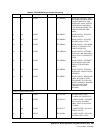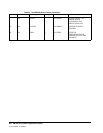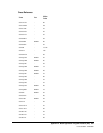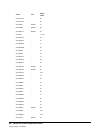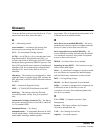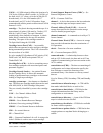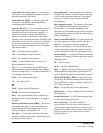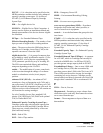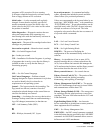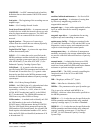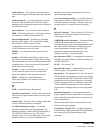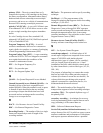
Glossary 657
1st ed., 6/30/04 - 312579601
control data set recovery area— A portion of the
CDS reserved for maintaining integrity for updates
that affect multiple CDS blocks.
control data set subfile— A portion of the CDS
consisting of Data Blocks and Pointer Blocks
containing related information.
Control Unit (CU)— (1) A microprocessor-based
unit situated logically between a host channel (or
channels) and from two to sixteen transports. It
functions to translate channel commands into
transport commands, send transport status to the
channel(s), and pass data between the channel(s) and
transport(s). (2) A device that controls I/O operations
for one or more devices. cross-host recovery. The
ability for one host to perform recovery for another
host that has failed.
CSE— Customer Service Engineer.
CSI— Consolidated System Inventory.
CSL— See Cartridge Scratch Loader.
CSRC— Central Support Remote Center (See
Remote Diagnostics Center)
CST— (1) A value that can be specified on the
MEDia parameter and that includes only standard
capacity cartridge tapes. (2) An alias of Standard. (3)
See Cartridge System Tape.
CSW— See Channel Status Word.
CU— See Control Unit.
D
DAE— Dump Analysis Elimination.
DASD— Direct access storage device.
data— Any representations such as characters or
analog quantities to which meaning is, or might be,
assigned.
Database Heartbeat record (DHB)— The record
that contains the names of the control data sets
recorded by the HSC and identifies the correct
primary, secondary, and standby CDS.
data class— A collection of allocation and space
attributes, defined by the storage administrator, that
are used to create a data set.
data compaction— An algorithmic data-reduction
technique that encodes data from the host and stores
it in less space than unencoded data. The original
data is recovered by an inverse process called
decompaction.
data-compaction ratio— The number of host data
bytes mathematically divided by the number of
encoded bytes. It is variable depending on the
characteristics of the data being processed. The more
random the data stream, the lower the opportunity to
achieve compaction.
Data Control Block (DCB)— A control block used
by access routines in storing and retrieving data.
data set— The major unit of data storage and
retrieval, consisting of a collection of data in one of
several prescribed arrangements and described by
control information to which the system has access.
data streaming— A continuous stream of data being
transmitted in character or binary-digit form, using a
specified format.
DC— Direct current.
DCB— See Data Control Block.
DD3— A generic value that can be specified on the
MEDia and RECtech parameters and includes all
types of helical cartridges and recording techniques.
DD3A, DD3B, DD3C, DD3D— Values that can be
specified on the MEDia parameter and include only
the specified type of helical cartridge. Aliases are A,
B, C, and D, respectively.
DDR— See Dynamic Device Reconfiguration.
default value— A value assumed when no value has
been specified.
demand allocation— An MVS term meaning that a
user has requested a specific unit.
device allocation— The HSC function of
influencing the MVS device selection process to
choose either a manual transport or a transport in a
particular ACS, based on the location of the volume
(specific requests) or the subpool rules in effect
(scratch requests).



